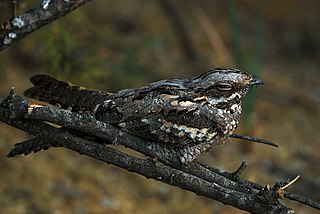
The European nightjar, common goatsucker, Eurasian nightjar or just nightjar, is a crepuscular and nocturnal bird in the nightjar family that breeds across most of Europe and the Palearctic to Mongolia and Northwestern China. The Latin generic name refers to the old myth that the nocturnal nightjar suckled from goats, causing them to cease to give milk. The six subspecies differ clinally, the birds becoming smaller and paler towards the east of the range. All populations are migratory, wintering in sub-Saharan Africa. Their densely patterned grey and brown plumage makes individuals difficult to see in the daytime when they rest on the ground or perch motionless along a branch, although the male shows white patches in the wings and tail as he flies at night.

The standard-winged nightjar is a nocturnal bird in the nightjar family. Previously placed with the pennant-winged nightjar in their own genus, Macrodipteryx, it is native to Africa and displays extreme sexual dimorphism. During the breeding season, males will grow broad ornamental flight feathers longer than their body.

The Indian nightjar is a small nightjar which is a resident breeder in open lands across South Asia and Southeast Asia. Like most nightjars it is crepuscular and is best detected from its characteristic calls at dawn and dusk that have been likened to a stone skipping on a frozen lake - a series of clicks that become shorter and more rapid. They are sometimes spotted on roads when their eyes gleam red in the spotlight of a vehicle. There is considerable plumage variation across its range and can be hard to differentiate from other nightjars in the region especially in the field.

Jerdon's nightjar is a medium-sized nightjar species native to southern India and Sri Lanka. Formerly considered as a subspecies of the long-tailed nightjar, it is best recognized by its distinctive call which sounds like a wooden plank being beaten periodically with each note ending in a quaver. The common name commemorates Thomas C. Jerdon who described the species.
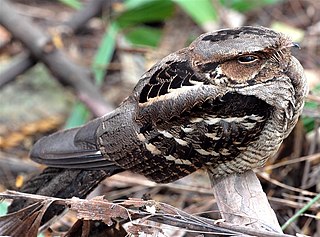
Caprimulgus is a large and very widespread genus of nightjars, medium-sized nocturnal birds with long pointed wings, short legs and short bills. Caprimulgus is derived from the Latin capra, "nanny goat", and mulgere, "to milk", referring to an old myth that nightjars suck milk from goats. The common name "nightjar", first recorded in 1630, refers to the nocturnal habits of the bird, the second part of the name deriving from the distinctive churring song.
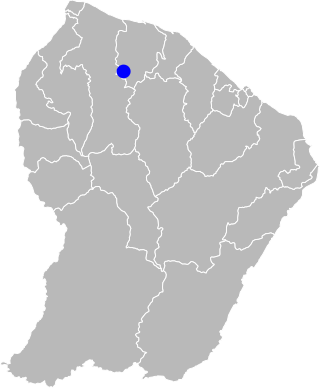
The Cayenne nightjar is a species of bird in the nightjar family only known from a single specimen, a male taken on the Fleuve Mana, French Guiana, in 1917. However, a possible female was caught at the Saül airstrip, French Guiana, in 1982.

The jungle nightjar is a species of nightjar found in the Indian Subcontinent. It is found mainly on the edge of forests where it is seen or heard at dusk. The taxonomy of this and related nightjars is complex and a range of treatments have been followed that cover this and several other nightjars in the Asian region. It was formerly called the grey nightjar or Indian jungle nightjar and sometimes included the East Asian grey nightjar as a subspecies.

The Sykes's nightjar, Sykes' nightjar, Sind nightjar or Sindh nightjar is a nightjar species found in northwestern South Asia. This species has a large range with stable population size and therefore has been listed as “Least Concern” with no prediction of substantial human influence on their habitats in the near future.
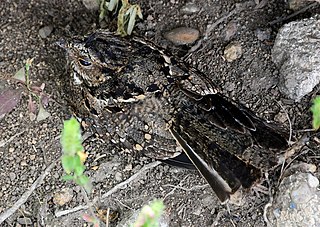
Anthony's nightjar, also known as the scrub nightjar, is a species of nightjar in the family Caprimulgidae. It is found in Ecuador and Peru.

Bates's nightjar or the forest nightjar, is a bird species of the family Caprimulgidae, native to the Congolian rainforests.

The Long-tailed Nightjar is one of 98 species of nightjar in the family Caprimulgidae, the "true nightjars". It is a nocturnal, insectivorous bird characterized by its distinctive long tail. It is found throughout mainland Africa in open areas, arid semi-deserts, and savannas, with common sightings alongside roadways.

The large-tailed nightjar is a species of nightjar known for its distinctive long, broad tail and cryptic plumage that allows it to blend into its surroundings. Found along the southern Himalayan foothills, eastern South Asia, Southeast Asia and northern Australia, its natural habitats are subtropical or tropical moist lowland forest, subtropical or tropical mangrove forest, and subtropical or tropical moist montane forest.
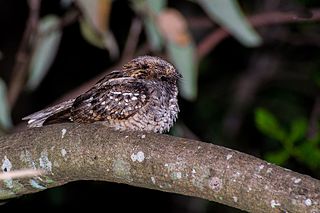
The little nightjar is a species of nightjar in the family Caprimulgidae. It is found in Argentina, Bolivia, Brazil, Paraguay, Peru, and Uruguay.

The fiery-necked nightjar is a species of nightjar in the family Caprimulgidae, which is found mostly in Africa south of the equator, though it has been spotted in a few countries north of the equator. It is most often found in woodland savannas or other deciduous woodlands. It is usually distinguished by its tawny coloured collar which gives the species its common name. It has a distinctive call that many have rendered as 'good-lord-deliver-us'. The fiery-necked nightjar is an insectivorous species that mostly eats butterflies, moths and other insects. The fiery-necked nightjar breeds after the dry season and typically produce two clutches with two eggs per clutch.

The Roraiman nightjar is a species of nightjar in the family Caprimulgidae. It is found in Brazil, Guyana, and Venezuela.

The white-winged nightjar is a species of nightjar in the family Caprimulgidae. It is found in Bolivia, Brazil and Paraguay.
The Itombwe owl is a species of owl in the barn owl family, Tytonidae. It is restricted to a small area in the Albertine Rift montane forests.
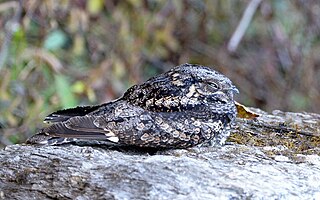
The grey nightjar is a species of nightjar found in East Asia, breeding from southeastern Russia south through China, the Korean Peninsula and Japan to northern Indochina and westward along the Himalayas. It is largely migratory, wintering in Indochina south to Java in Indonesia, but is resident in warmer areas in the south of its breeding range. It is sometimes treated as a subspecies of the jungle nightjar, its South Asian relative. The grey nightjar breeds and forages in early successional habitats surrounded by forests; its populations have declined since the 1970s in Japan. Like all nightjars, it is crepuscular to nocturnal, feeding on flying insects, including moths, beetles, flying ants, grasshoppers, and others.

Tschudi's nightjar or lesser band-winged nightjar is a species of nightjar in the family Caprimulgidae. It is found in Chile and Peru.
Alexandre Romanovich Prigogine was a Belgian mineralogist and ornithologist of Russian-Jewish origin.

















